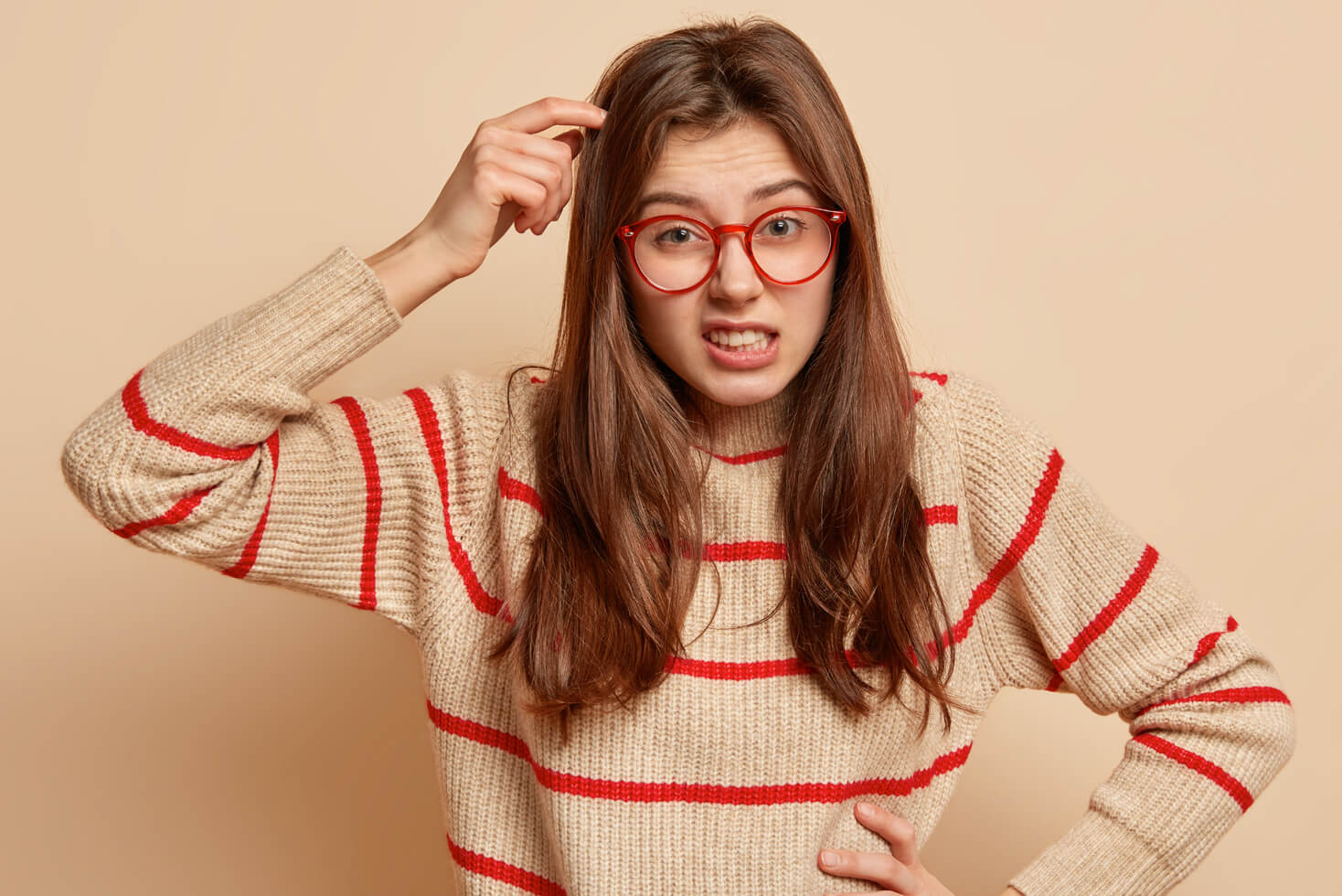Product Buildup in Hair – Common Signs and Symptoms
Updated on
This post may contain affiliate links. As an Amazon Associate, we may earn from qualifying purchases.

Hair product buildup can be the reason why your hair doesn’t look or feel as good as it used to.
Dry, limp, lifeless, lack of volume, frizzy, and impossible to style are some of the tell-tale signs that you have product buildup lurking in your hair.
You see, over time, styling products like sprays, serums, waxes, creams, and so on leave behind their sneaky by-products such as silicone, mineral oils, polyquats, polymers, and other chemicals that make your tresses glossy and smooth but still, leave behind sticky residues that are non-soluble.
And non-soluble products won’t wash away easily with regular shampoos. Instead, they bind to the hair strands and deposit onto the scalp clogging the follicles. As a result, the hair strands become brittle and break easily, and the scalp irritates.
That’s why I recommend using a clarifying shampoo as an essential part of any hair care routine.
Table of Contents
- What is Product Buildup?
- What Does Product Buildup Look Like?
- What Does Product Buildup on Hair Feel Like?
- What Causes Product Buildup?
- How to Tell if You Have Product Buildup In Hair?
- Your Hair Feels Dry But Your Scalp Feels Greasy
- Your Hair Looks Dull All The Time
- Your Hair Feels Rough and Stiff Every Day
- You Find Yourself Using Way More Shampoo Than Usual
- Your Hair Struggles To Hold A Style
- Lack of Volume
- You Have Severe Hair Breakage
- Itchy and Irritating Scalp
- Loss of Curl Pattern in Curly and Natural Hair
- How Product Buildup Affects Hair and Scalp
- How to Do a Hair Buildup Test at Home
- How to Remove Product Buildup
- Time to Give Your Hair A Weekly Deep Cleanse!
What is Product Buildup?
Product buildup is the progressive accumulation and layering of leftovers from sprays, gels, creams, serums, conditioners, and shampoos on the hair strands and scalp.
Anything that adds gloss and smoothness to your hair is likely to contain ingredients like silicone, wax, mineral oil, and other similar chemicals. These are the by-products that stick to the hair, and instead of washing out, they cling on to your locks creating layers after layers.

Over time, these layers of product accumulation obstruct moisture, forcing your conditioners to stay on top rather than absorb into the hair.
What Does Product Buildup Look Like?

Product buildup in hair looks like blobs, white film, or chunky flakes that stick to the strands like tiny lumps. You can see product buildup when you part your hair in sections and rub your fingers through the parting. It’s the scaly film under your fingernails. Yep – that’s the yucky stuff that’s been building for a while!
The product residue will stick around for a long time if you don’t use a clarifying product to wash it away.
Clogged hair follicles will eventually lead to scalp irritation – itching, scaling, inflammation, and sometimes infection.
What Does Product Buildup on Hair Feel Like?
Some signs that product buildup may have occurred in your locks are dryness, lack of shine, tangling, breaking, and difficulty combing through knots.
Your scalp will feel greasy, and yet your hair will feel parched all the time. In some cases, you may also see white flakes and dandruff piling up in between your partings.
What Causes Product Buildup?

Any hair styling cosmetic that promises to make your hair shiny, smooth, and glossy will most likely use ingredients like silicone, mineral oils, and polymers that layer over the hair shaft. These ingredients add a non-soluble barrier to lock out humidity and prevent environmental factors from disrupting your hairstyle.
However, these cosmetic components can be stubborn to rinse out. They progressively attach to the hair, causing layers of excessive deposits. If you zoom in on an individual hair strand, this looks like a grimy coating.
How to Tell if You Have Product Buildup In Hair?
Listen to how your hair feels and reacts. If it’s starting to lose its shine and thunder, and it’s taking you forever to get your locks on fleek every day, chances are, you have a lot of buildup in your hair.
So watch out for these signs and symptoms:
Your Hair Feels Dry But Your Scalp Feels Greasy
This is the most obvious sign of product residues and build-up causing an imbalance. This happens because the hair strands are struggling to absorb moisture, and the scalp is fighting back by producing more sebum to unclog its pores.
The result: A combination of oily roots and dry ends.
Your Hair Looks Dull All The Time
Dull-looking hair and a lack of shine are obvious signs that your locks are coated with products.
Buildup makes your hair look lackluster, heavy, greasy, and limp.
Your Hair Feels Rough and Stiff Every Day
The inability to soak in nutrients and moisture from conditioners, moisturizers, and masks will make your hair strands dry, weak, and brittle. As a result, they start to wither and frizz, making them rough and stiff.
You Find Yourself Using Way More Shampoo Than Usual
Your hair never feels clean.
There’s always that feeling of dirt and greasiness sitting on your scalp. That’s because your scalp is working harder to produce sebum to fight back against the product’s remnants that are clogging the pores.
This creates a vicious cycle of washing and the scalp getting greasy fast again.
To break out of this cycle, you need an exfoliating shampoo that can scrape the waxy layers off the hair strands.
Your Hair Struggles To Hold A Style
When your hair feels stiff and lacks elasticity and bounce, it becomes a nightmare to style. Forget fancy hairstyles. The only thing you’ll be doing is shoving your heaping nest of locks into an elastic band and let it be.
Lack of Volume
Dry and lackluster hair will never lift from the roots. It will always feel flat and drab no matter how much volumizing sprays you use. It becomes near impossible to unlock volume and definition when your hair is layered with grime.
You Have Severe Hair Breakage
Dry and unhealthy hair will eventually lead to hair breakage from mid-length onwards. As your hair withers due to lack of moisture, it also struggles to maintain length. The older parts start to crack and crumble like dry twigs unless you nurture them back into healthy strands.
Itchy and Irritating Scalp
A clogged scalp is an angry scalp. As stuff builds up near your hair roots, the scalp pores get congested.
As a result, the clogged pores get infected, inflamed, and the scalp starts to irritate and fight back against the grime.
Loss of Curl Pattern in Curly and Natural Hair
If your natural hair struggles to hold definition and its true curl pattern, it’s a sign that your curls are overwhelmed with moisture-blocking filth that’s making your products inefficient.
How Product Buildup Affects Hair and Scalp
When products build up, they leave behind a layer of residues on your scalp and hair. The product glues itself to the surface of each strand, making them rough, inelastic, and unable to soak in moisture.
Eventually, the hair fibers become brittle, frizzy, and rough, causing them to tangle easily and break mid-way through.
As for the scalp, product build-up can clog the pores causing inflammation and dandruff in the long term.
How to Do a Hair Buildup Test at Home
Check out these cool hacks that will help you assess how much buildup is in your hair.
Hair Scape Test
- Make sure your hair is not washed or wet
- Grab a pair of scissors
- Grab a small section of your hair to test
- Run the scissor blade down the length of your locks
- See how many lines of white waxy residues peel off
Credit to Boston-based hairstylist Daleen Jordan who shared this trick on her Instagram feed. I tried it at home too, and it worked!
See it here: Viral video shows hair buildup caused by drugstore shampoo
Scratch Your Scalp
- Create a parting on your hair
- Run your fingernails gently along the parting
- Check how much waxy residues accumulate below your nails
It will feel gross, but that’s also a surefire way to know how much product remnants have accumulated since the last time you deep cleansed your hair (if you ever did!)
If you feel most of the buildup is concentrated on your scalp, you can also use a dandruff comb to loosen up the flakes before washing your hair.
How to Remove Product Buildup
The best solution to banish product buildup is to add a regular deep cleansing treatment to your hair care routine. Once a week is good enough to start, but you will have to be consistent with it.
Here are some excellent solutions that work:
Use a Clarifying Shampoo
A clarifying shampoo sweeps away every scrap of buildup and goes deep into the pores to remove impurities that are clogging the scalp.
It thoroughly cleanses, exfoliates, and moisturizes in one sweep.
Use it weekly and see how it lifts your hair. It’s an excellent way to detox both the hair and scalp.
Do an Apple Cider Vinegar Rinse
Apple cider vinegar has antibacterial and deep cleansing properties, which help remove dirt, greasiness, and product leftovers from both the hair and scalp. It also has low pH, which helps smoothen the hair and keep the scalp healthy.
Try it once every week, and you’ll notice the immediate benefits.
Recommended product:
Braggs Apple Cider Vinegar
Try a Baking Soda Scrub
Baking soda is a popular DIY ingredient that can be used to exfoliate the scalp. Many people who do the No Poo Method use it to cleanse their scalp, but you should exercise caution as it can raise the hair’s pH.
Here’s a good recipe from MindBodyGreen you can try:
DIY Baking Soda Shampoo Recipe.Try a Micellar Water Shampoo
Micellar cleansers are excellent at removing product buildup in hair because they work like dirt magnets. Plus they are gentle, non-stripping, and sulfate-free.
Micellar water binds to impurities to make them soluble so that any sticky residues can be rinsed out of your hair with pure water.
Pantene Pro-V Shampoo with Micellar Water
The Pantene Pro-V Micellar Shampoo is designed for women who want to get away from greasy, heavy hair that’s been weighed down by too many conditioners. It has an exclusive formula that lifts out oils, residues, and hard buildup without drying your locks and your scalp.
Time to Give Your Hair A Weekly Deep Cleanse!
Product buildup doesn’t happen overnight. It’s a gradual accumulation over time as products are applied and left in the hair without being rinsed out. So don’t blame the last product you put in.
Follow a weekly deep cleansing routine with a clarifying shampoo to make sure sticky leftovers like silicone, waxes, and gels are properly purged.
Trust me – It will make your hair feel lighter, your scalp healthier, and overall your hair will feel better and easier to style and manage.
About the Author
 Kassidy Ward
Kassidy WardKassidy Ward is our curly girl expert and has been following the Curly Girl Method for over 3 years. She's tried just about every product and technique out there to get her curls to cooperate and is always on the lookout for new products to try.
She's also a sucker for free products, which is why she's relentlessly reaching out to manufacturers with her unique persuasive skills. 9 out of 10 times, she wins!

